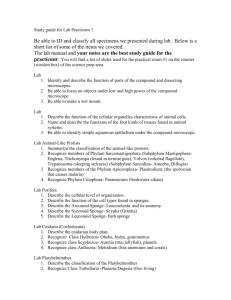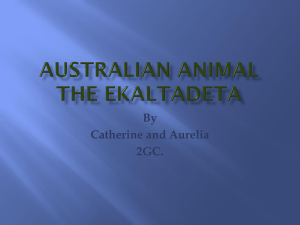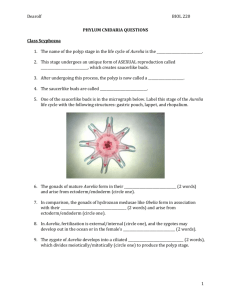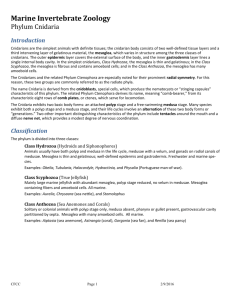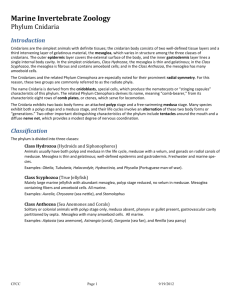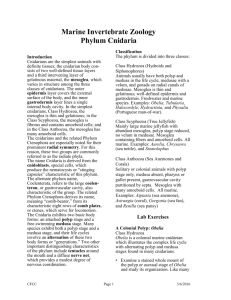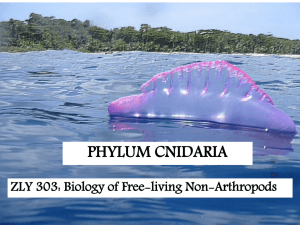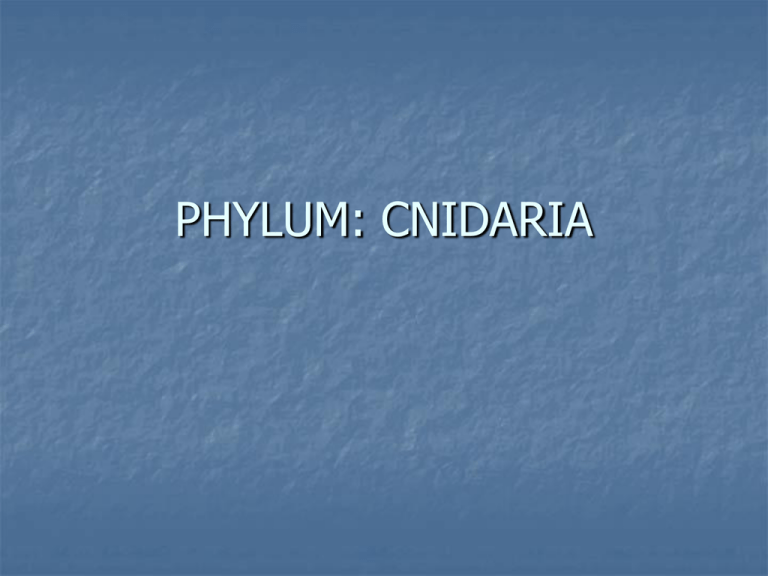
PHYLUM: CNIDARIA
Classes of Cnidaria
Class
Class
Class
Class
Hydrozoa (e.g., Hydra, Obelia)
Scyphozoa (e.g., Aurelia)
Cubozoa (e.g., cube jellies)
Anthozoa (anemones and corals)
Subclass Hexacorallia (sea anemones, hard
corals)
Subclass Octocarallia (sof corals)
General Characteristics
Entirely aquatic; mostly marine, but with a
few freshwater species;
may be solitary or colonial
Metazoan, with true tissues.
Diploblastic – two germ layers
outer cell layer known as ectoderm
(epidermis),
inner cell layer known as endoderm
(=gastrodermis),
with a non-cellular mesoglea between.
General Characteristics
The internal body space (gastrovascular
cavity) lined with gastrodermis
has a mouth, but no anus (incomplete
digestive tract)
Possess cnidocytes with special cell
organelles - nematocysts, used for
defense and offense
General Characteristics cont.
Phylum exhibits polymorphism
Metagenesis- alternation of generation
Polyp (often sessile) and the medusa (free
swimming).
The polyp stage reproduce asexually,
while the medusa stage usually
reproduces sexually
Reproduction is asexual by budding and/or
sexual, producing a ciliated planula larva
Figure 13.02
Two general
body forms
Class Hydrozoa
solitary or colonial
alternation of asexual polyps and sexual
medusae
Figure 13.09
Life Cycle of Hydra
SEXUAL
REPRODUCTION
ASEXUAL
REPRODUCTION
Hydra with Bud
Ovary
Bud
Hydra with Gonads
Testes
Hydra c.s.
Gastrovascular
cavity
Epidermis
Mesoglea
Gastrodermis
Figure 13.09
Obelia Life Cycle
Obelia - Medusa
Gonad
Tentacle
Gastrovascular cavity
Obelia – Hydroid colony
Gastrozoids = Hydranth
Gonozoids = Gonangium
Obelia – Hydroid Colony
Gonozooid
Hydrozooid
Gonionemus
Gonad
Physalia –
Portuguese Man-O-War - a colony, not an
individual
It is not a jellyfish!!
Class Scyphozoa
True Jellyfishes
polyp stage reduced or absent
bell-shaped medusae
margin of bell with eight notches which
are provided with sense organs
all marine
Aurelia - Medusa
Aurelia - Planula larva
Aurelia - Scyphistoma
Aurelia - Strobila
Aurelia - Ephyra
Class – Anthozoa
Sea Anemones and Corals
all species occur as polyps only, no
medusae;
gastrovascular cavity partitioned by at
least eight septa with nematocysts
Solitary or colonial
all marine.
Some Hydrozoans
Figure 13.07
0022.jpg
Figure 13.15a
Figure 13.15b
Some Scyphozoans
Jellyfishes
Figure 13.16
Figure 13.17
Some Anthozoans
Sea Anemones
Figure 13.25
Figure 13.29
Corals
Figure 13.32
Figure 13.33a
Figure 13.33b
Figure 13.28
0039.jpg
0041.jpg
0047.jpg
0048.jpg
Figure 13.26b
Figure 13.26c
0049.jpg
0050.jpg
Phylum Ctenophora
The Combjellies
General Characteristics
Biradial symmetry
Eight rows of comb plates
Tentacles possess colloblasts
Triploblastic (three cell or germ layers)
Mesoglea (loose mesenchyme) is jelly-like material
strews with fibers and amebocytes and contains true
muscle cells
Aboral sense organ (statocyst)
Digestive system: mouth, pharynx, stomach, branched
canals and anal pore
Monoecious, with both eggs and sperm produced from
endodermal lining of digestive canals beneath comb
plates
Figure 13.36
Figure 13.36a
Figure 13.38
Figure 13.38a
Figure 13.38b
Figure 13.35
0002.jpg

